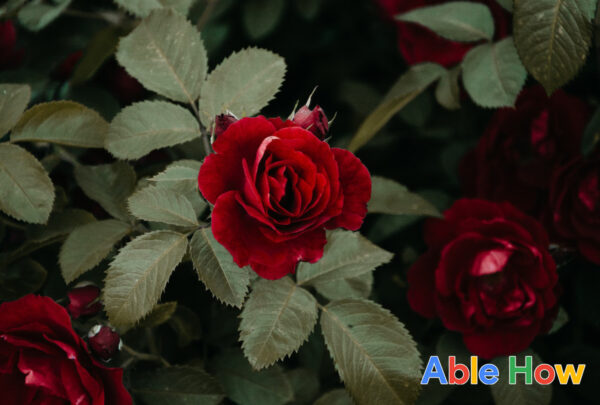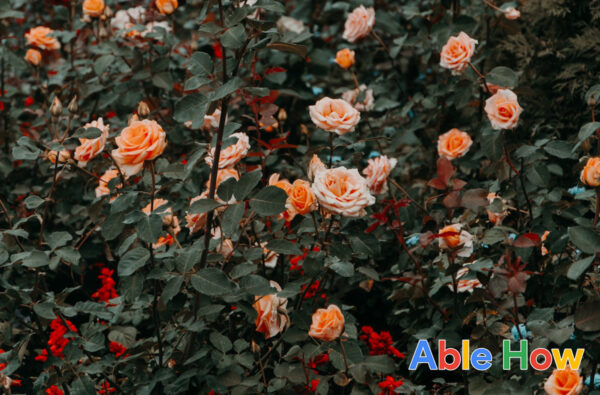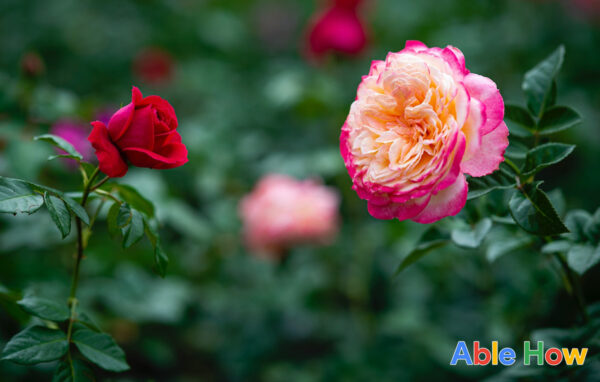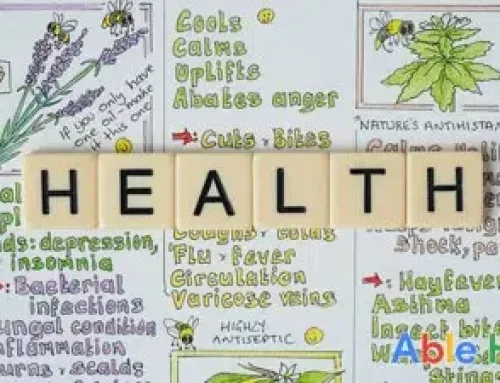How to Create a
Beautiful Rose Garden
How to
Start Career in IT
Creating your own rose garden can be a labor of love — but the rewards are sweet. In this article, we’ll take you through everything you need to know about growing and maintaining your own rose garden. We’ll cover the basics of selecting the right roses for your garden, choosing the right soil, and taking care of your plant as it grows. Plus, we’ll give you some tips on how to keep your roses healthy and vibrant once they bloom!
Why create rose garden?
- For passion.
- As hobby
- Symbol of beauty
- Collaboration with nature
You will learn from this article:
- Preparing Garden
- Choosing the Right Roses
- Planting
- Fertilizing
- Dealing With Pests
- Balanced Ecosystem
How to Create a Beautiful Rose Garden Full Guide
How to start a career in IT(*)
1. Preparing Your Garden for Rose Planting
Gardening isn’t just about how you choose to decorate your garden with plants, it’s also about the preparation of your soil and planting area. So before you go out and buy those beautiful roses, it’s important to make sure your garden is ready for them.
The first step is to pick a suitable spot in your garden that receives at least six hours of sunlight per day and use a trowel or spade to loosen the soil up, digging a hole that is wider and deeper than the pot your rose came in. Make sure the area has good drainage by digging small trenches if necessary.
The next step is to amend the soil; add in some compost or well-aged manure so that it can give your roses all the nutrients they need to grow big and strong. When mixing it with the soil, make sure there are no lumps or deep spots since even ground and polishing will help promote healthy root growth for your roses.
2. Choosing the Right Roses for Your Garden
Choosing the right roses for your garden may seem overwhelming at first, but don’t worry—it’s simpler than it looks. When selecting which roses to plant in your garden, begin by thinking about which colors you’d like to have. Red roses? Yellow roses? White roses? Make sure to also look into their fragrance—you want a garden that is as beautiful as it is fragrant!
Next, consider how much care and sun each rose needs to thrive. You don’t want to overtax yourself in terms of caring for your garden, so make sure you select varieties that fit the amount of sun and care that you can provide. You can also look into disease-resistant varieties or everblooming options if they’re available in your area. remember that rose gardening is a long-term project. Roses usually take several years to reach full maturity, so patience is key when creating your dream rose garden!
3. Planting, Spacing and Caring for Your Roses
Now it’s time for the most exciting part—planting your beautiful roses! To make sure each rose gets enough space and sunlight, keep an eye on the spacing as you plant. Generally speaking, it’s best to plant 15-24 inches apart, depending on the type of rose you’re planting. When placing each one in the ground, dig a hole that’s twice as wide as the root ball, and gently loosen any roots so they can spread out more easily. Don’t forget to water them liberally after planting— this will help jumpstart their growth.
If you’re careful, you can create an esthetic with your roses — group them in a way that will add shape and texture to your garden design. For example, you can line up single-color roses at regular intervals for a stately look or put multi-colored roses together for a cheerful display.
4. After Planting Your Roses:
Now that your roses are planted safely in the ground, here’s what needs to be done next:
- Apply mulch around the plants’ bases – don’t forget to leave about an inch of space between the base of each rose and mulch for better aeration
- Fertilize regularly according to product instructions
- Prune – this helps reduce disease and spurs new growth
- Monitor for pests – if necessary, start treating them right away with natural insecticides or fungicides
- Water deeply once per week during dry weather
5. Fertilizing and Pruning Techniques for Roses
Now that you’ve chosen your roses wisely, it’s time to move on to the practical part of creating a beautiful rose garden. Fertilizing and pruning are both important components in rose gardening to ensure healthy growth and stunning blossoms.
Fertilizing
Fertilizing is often forgotten about, but it’s an essential part of ensuring that your roses reach their maximum potential. During their active season (April to August), roses will benefit from being fertilized with a balanced fertilizer that contains equal amounts of nitrogen, phosphorus and potassium. This will help the plants grow strong stems and roots while they grow. You can apply the fertilizer once a month up to four times during this season.
Pruning
Pruning is also essential if you want beautiful roses in your garden. Pruning helps keep the shape desired by allowing more light, air circulation and nutrients into each plant. It encourages healthy growth, as well as stops disease or pests from infecting all of the branches on the plant at once. Prune in late summer or early fall before frost comes in order for the plant to heal properly before winter sets in. Make sure you use sterilized tools when pruning, not just any pair of scissors!
These two techniques will help ensure your roses are healthy and prosperous for many years to come. With proper care and maintenance, you’re sure to have a stunning rose garden all year round!
6. Dealing With Pests and Diseases in the Rose Garden
Dealing with pests and diseases in the rose garden is an art form in and of itself. While it’s beneficial to get rid of them as soon as they appear, you should also be aware that these creatures play an important role in the ecosystem of your garden, and getting rid of them should involve plans that are not only effective, but also sustainable and eco-friendly.
Here are a few tips to help you take care of pests and diseases without doing harm to your garden:
- Monitor regularly. Keep an eye out for any signs of pests or diseases. By understanding what your roses need, you can easily detect if something is wrong with them.
- Remove affected parts. If there are any affected parts, remove them and destroy them away from the garden to avoid spreading the disease further.
- Use natural solutions. If you need to get rid of pests, look for natural solutions like sticky traps, horticultural oils, or insecticides made from plants instead of chemical insecticides that can leave residues that could harm wildlife or pollute ground water supplies.
- Practice prevention by taking extra care when watering your roses and by making sure they have enough sunlight. In addition, avoid overcrowding plants in small areas as this can lead to a buildup of moisture that can attract fungi and other diseases.
By taking the time to understand how pests and diseases work so that you can come up with eco-friendly solutions that won’t damage your rose garden over time, you can avoid many problems while still keeping your garden and its inhabitants safe.

7. Creating a Balanced Ecosystem for Your Roses
Creating a balanced garden ecosystem is key to keeping your roses healthy and beautiful. Your garden is not just the flowers — it’s also the soil, the water and how you manage insects and other animals.
Here are some tips on how to create a balanced ecosystem in your rose garden:
Start composting
Compost is an essential ingredient for healthy soil, especially if you’re growing roses. You can begin composting with kitchen scraps, paper and other yard waste, like leaves and grass clippings. Mix them together in a compost bin or heap and turn it regularly to provide oxygen so that your compost can breakdown more quickly.
Incorporate mulch
Adding mulch around your roses helps keep weeds away, retain moisture in the soil and add organic material as it breaks down. You can choose from a range of organic materials like straw, wood chips, shredded leaves or bark for this purpose.
Provide water regularly
Roses need regular watering to stay healthy — about an inch every week of rain or irrigation during dry weather — but be careful not to overwater or leave standing water around the plants, since this can cause fungal problems.
Caring for your garden requires effort, but with these steps you’ll be well on your way to creating a beautiful rose garden!
Attract beneficial insects
Attracting beneficial insects is an important element of creating a balanced ecosystem in your garden. Beneficial insects can help control pests and help pollinate your roses. Examples of beneficial insects include ladybugs, lacewings, hoverflies and bees. You can plant flowers like yarrow, calendula or alyssum to attract them.
Plant a diversity of flowers
Create a diverse garden that offers pollen and nectar to a variety of beneficial insects. Plant flowers like dahlias, coreopsis and aster, which can attract bees and other pollinators. Plant other flowers like pansies and snapdragons, which can attract beneficial insects that feed on pests in the garden.
Control pests naturally
A balanced garden ecosystem won’t experience too many pest problems, but if you do have issues, there are natural solutions. For example, you can use row covers, sticky traps and copper barriers to keep pests away. You can also try using biological control agents such as Bacillus thuringiensis to keep caterpillars at bay.
Creating a balanced ecosystem in your rose garden involves a lot of effort, but with a little research and dedication, you can create a beautiful, healthy garden that will attract beneficial insects and withstand disease and pest pressures.

How to Create a Beautiful Rose Garden(*)
How to start a career in IT(*)
1.Preparing Your Garden for Rose Planting
Gardening isn’t just about how you choose to decorate your garden with plants, it’s also about the preparation of your soil and planting area. So before you go out and buy those beautiful roses, it’s important to make sure your garden is ready for them.
The first step is to pick a suitable spot in your garden that receives at least six hours of sunlight per day and use a trowel or spade to loosen the soil up, digging a hole that is wider and deeper than the pot your rose came in. Make sure the area has good drainage by digging small trenches if necessary.
The next step is to amend the soil; add in some compost or well-aged manure so that it can give your roses all the nutrients they need to grow big and strong. When mixing it with the soil, make sure there are no lumps or deep spots since even ground and polishing will help promote healthy root growth for your roses.
2.Choosing the Right Roses for Your Garden
Choosing the right roses for your garden may seem overwhelming at first, but don’t worry—it’s simpler than it looks. When selecting which roses to plant in your garden, begin by thinking about which colors you’d like to have. Red roses? Yellow roses? White ones? Make sure to also look into their fragrance—you want a garden that is as beautiful as it is fragrant!
Next, consider how much care and sun each rose needs to thrive. You don’t want to overtax yourself in terms of caring for your garden, so make sure you select varieties that fit the amount of sun and care that you can provide. You can also look into disease-resistant varieties or everblooming options if they’re available in your area.Finally, remember that rose gardening is a long-term project. Roses usually take several years to reach full maturity, so patience is key when creating your dream rose garden!
3.Planting, Spacing and Caring for Your Roses
Now it’s time for the most exciting part—planting your beautiful roses! To make sure each rose gets enough space and sunlight, keep an eye on the spacing as you plant. Generally speaking, it’s best to plant 15-24 inches apart, depending on the type of rose you’re planting.
When placing each one in the ground, dig a hole that’s twice as wide as the root ball, and gently loosen any roots so they can spread out more easily. Don’t forget to water them liberally after planting— this will help jumpstart their growth.
If you’re careful, you can create an esthetic with your roses — group them in a way that will add shape and texture to your garden design. For example, you can line up single-color roses at regular intervals for a stately look or put multi-colored roses together for a cheerful display.
4.After Planting Your Roses:
Now that your roses are planted safely in the ground, here’s what needs to be done next:
- Apply mulch around the plants’ bases – don’t forget to leave about an inch of space between the base of each rose and mulch for better aeration
- Fertilize regularly according to product instructions
- Prune – this helps reduce disease and spurs new growth
- Monitor for pests – if necessary, start treating them right away with natural insecticides or fungicides
- Water deeply once per week during dry weather
5.Fertilizing and Pruning Techniques for Roses
Now that you’ve chosen your roses wisely, it’s time to move on to the practical part of creating a beautiful rose garden. Fertilizing and pruning are both important components in rose gardening to ensure healthy growth and stunning blossoms.
Fertilizing
Fertilizing is often forgotten about, but it’s an essential part of ensuring that your roses reach their maximum potential. During their active season (April to August), roses will benefit from being fertilized with a balanced fertilizer that contains equal amounts of nitrogen, phosphorus and potassium. This will help the plants grow strong stems and roots while they grow. You can apply the fertilizer once a month up to four times during this season.
Pruning
Pruning is also essential if you want beautiful roses in your garden. Pruning helps keep the shape desired by allowing more light, air circulation and nutrients into each plant. It encourages healthy growth, as well as stops disease or pests from infecting all of the branches on the plant at once. Prune in late summer or early fall before frost comes in order for the plant to heal properly before winter sets in. Make sure you use sterilized tools when pruning, not just any pair of scissors!
These two techniques will help ensure your roses are healthy and prosperous for many years to come. With proper care and maintenance, you’re sure to have a stunning rose garden all year round!
6.Dealing With Pests and Diseases in the Rose Garden
Dealing with pests and diseases in the rose garden is an art form in and of itself. While it’s beneficial to get rid of them as soon as they appear, you should also be aware that these creatures play an important role in the ecosystem of your garden, and getting rid of them should involve plans that are not only effective, but also sustainable and eco-friendly.
Here are a few tips to help you take care of pests and diseases without doing harm to your garden:
- Monitor regularly. Keep an eye out for any signs of pests or diseases. By understanding what your roses need, you can easily detect if something is wrong with them.
- Remove affected parts. If there are any affected parts, remove them and destroy them away from the garden to avoid spreading the disease further.
- Use natural solutions. If you need to get rid of pests, look for natural solutions like sticky traps, horticultural oils, or insecticides made from plants instead of chemical insecticides that can leave residues that could harm wildlife or pollute ground water supplies.
- Practice prevention by taking extra care when watering your roses and by making sure they have enough sunlight. In addition, avoid overcrowding plants in small areas as this can lead to a buildup of moisture that can attract fungi and other diseases.
By taking the time to understand how pests and diseases work so that you can come up with eco-friendly solutions that won’t damage your rose garden over time, you can avoid many problems while still keeping your garden and its inhabitants safe.

7.Creating a Balanced Ecosystem for Your Roses
Creating a balanced garden ecosystem is key to keeping your roses healthy and beautiful. Your garden is not just the flowers — it’s also the soil, the water and how you manage insects and other animals. Here are some tips on how to create a balanced ecosystem in your rose garden:
Start composting
Compost is an essential ingredient for healthy soil, especially if you’re growing roses. You can begin composting with kitchen scraps, paper and other yard waste, like leaves and grass clippings. Mix them together in a compost bin or heap and turn it regularly to provide oxygen so that your compost can breakdown more quickly.
Incorporate mulch
Adding mulch around your roses helps keep weeds away, retain moisture in the soil and add organic material as it breaks down. You can choose from a range of organic materials like straw, wood chips, shredded leaves or bark for this purpose.
Provide water regularly
Roses need regular watering to stay healthy — about an inch every week of rain or irrigation during dry weather — but be careful not to overwater or leave standing water around the plants, since this can cause fungal problems.
Caring for your garden requires effort, but with these steps you’ll be well on your way to creating a beautiful rose garden!
Attract beneficial insects
Attracting beneficial insects is an important element of creating a balanced ecosystem in your garden. Beneficial insects can help control pests and help pollinate your roses. Examples of beneficial insects include ladybugs, lacewings, hoverflies and bees. You can plant flowers like yarrow, calendula or alyssum to attract them.
Plant a diversity of flowers
Create a diverse garden that offers pollen and nectar to a variety of beneficial insects. Plant flowers like dahlias, coreopsis and aster, which can attract bees and other pollinators. Plant other flowers like pansies and snapdragons, which can attract beneficial insects that feed on pests in the garden.
Control pests naturally
A balanced garden ecosystem won’t experience too many pest problems, but if you do have issues, there are natural solutions. For example, you can use row covers, sticky traps and copper barriers to keep pests away. You can also try using biological control agents such as Bacillus thuringiensis to keep caterpillars at bay.
Creating a balanced ecosystem in your rose garden involves a lot of effort, but with a little research and dedication, you can create a beautiful, healthy garden that will attract beneficial insects and withstand disease and pest pressures.

Click Here to read more important articles!
Video





Leave A Comment